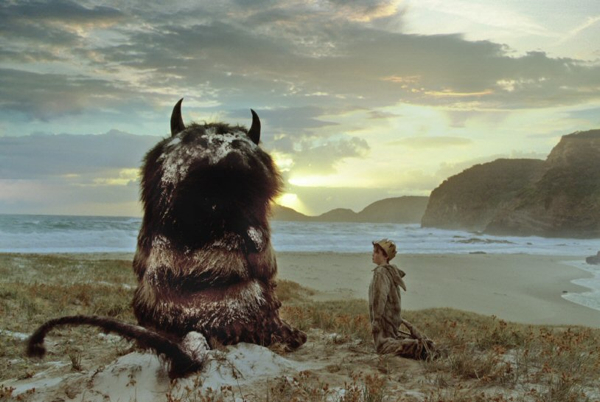Movie review by Greg Carlson
So potent is the alchemy of Maurice Sendak’s 1963 “Where the Wild Things Are” that writers, critics, and bloggers have recently generated the equivalent of several monographs addressing its potentialities of meaning: J. Hoberman notes John Cech’s “Angels and Wild Things: The Archetypal Poetics of Maurice Sendak,” Jack Shafer visits Sendak’s longstanding animosity directed against Bruno Bettelheim, and Dana Stevens mentions a Bill Moyers interview – one of several places where Sendak revealed that the inspiration for the design of his hallmark creatures bubbled up from indigestible memories of his grotesque relatives demanding food, attention, and kisses.
Spike Jonze’s lavishly budgeted adaptation contributes another chapter to the media history of the Wild Things, joining Gene Deitch’s 1973 animated short and Oliver Knussen’s 1980s opera. Following an intimate and keenly observed opening section that introduces the painful isolation of Max (Max Records), the wolf-suited child sets sail for the titular domain. Upon arrival, he encounters the Wild Things, is quickly appointed king, and sets about declaring the start of the wild rumpus, which involves more tree smashing than the book. Uneasy lies the head that wears a crown, and Max morphs from mischief-maker to harried parent, navigating the strange grievances of his subjects and intervening in their squabbles.
Jonze and his collaborators commendably respect the essence of Sendak’s original, even as they enlarge to feature-length running time a work that takes about seven minutes to read. Do not, however, expect an exact replica. In “Heads On and We Shoot: The Making of Where the Wild Things Are,” a beautiful companion book to the movie that offers pleasures distinct from the film watching experience, Jonze and co-screenwriter Dave Eggers share the anecdote that Sendak was adamantly opposed to the film’s omission of the bedroom-to-forest transformation scene. Sendak’s objection proves correct, and despite Jonze’s self-defense, many aficionados will sorely miss the treasured sequence.
Additionally, something is lost in the act of assigning names to the unnamable Wild Things, who remained mystically anonymous in the original text. Sendak’s application of the names of relations for the Knussen opera (Moishe, Tzippy, Bernard, Bruno, and Emile) are jettisoned in favor of new monikers Carol, KW, Judith, Ira, Alexander, and Douglas. The human-sounding appellations ground the creatures in the kind of realism identified by Jonze as a crucial component of his version of the Wild Things. Identification through naming can also impart unanticipated consequences related to classification, assimilation, and limitation, narrowing possibilities by ruling out all the things that Things are not.
Sendak, credited as one of the film’s producers, has been publicly supportive of Jonze’s vision, and the director’s melancholy – some have said depressing – construction of Max’s imaginative odyssey is strikingly bold and clearly personal. Perhaps the Wild Things, voiced by performers including James Gandolfini, Lauren Ambrose, Catherine O’Hara, Forest Whitaker, Chris Cooper, and Paul Dano, say too much, too often. Considering, however, that so many other directors might have made a garish, instantly dated hash of the source material – “ How the Grinch Stole Christmas” (2000) and “The Cat in the Hat” (2003) jump immediately to mind – “Where the Wild Things Are” exists in a unique class.
